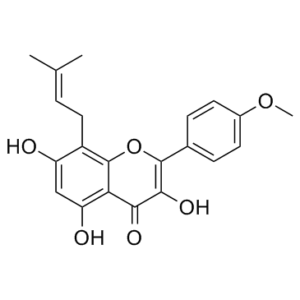Icaritin
This product is for research use only, not for human use. We do not sell to patients.

For small sizes, please check our retail website as below: www.invivochem.com
| Size | Price | Stock |
|---|---|---|
| 100mg | $450 | To Be Confirmed |
| 200mg | $675 | To Be Confirmed |
| 500mg | $1135 | To Be Confirmed |
Cat #: V22391 CAS #: 118525-40-9 Purity ≥ 99%
Description: Icaritin (Anhydroicaritin) is a naturally occurring flavonoid isolated frp, Epimedium brevicornuMaxim.
Top Publications Citing Invivochem Products
Publications Citing InvivoChem Products
Product Promise

- Physicochemical and Storage Information
- Protocol
- Related Biological Data
- Stock Solution Preparation
- Quality Control Documentation
| Molecular Weight (MW) | 368.38 |
|---|---|
| Molecular Formula | C21H20O6 |
| CAS No. | 118525-40-9 |
| SMILES Code | O=C1C(O)=C(C2=CC=C(OC)C=C2)OC3=C(C/C=C(C)\C)C(O)=CC(O)=C13 |
| Synonyms | Icaritin |
| Protocol | In Vitro | Icaritin (0-64 µM; 48 hours; K562 and primary cells) treatment induces K562 or primary cells apoptosis in an concentration dependent manner. Icaritin (4-64 µM; 48 hours; K562, imatinib-resistant cells and primary CML cells) treatment inhibits proliferation of K562, imatinib-resistant cells and primary CML cells . Icaritin (0-64 µM; 48 hours; K562 cells) treatment inhibits MAPK/ERK/JNK downstream signaling and diminishes Jak2/Stat3/Akt expression. Icaritin treatment also significantly inhibits Bcl-2 protein expression and up-regulated Bax protein expression in K562 with a dose-dependent manner accompanied by the cleavage activation of caspase-3 or caspase-9, and a down-regulated expression of Apaf-1. Icaritin (32 µM; K562 cells) treatment increases cell population in the sub-G1 phase in K562 cells. |
|---|---|---|
| In Vivo | Icaritin (4-8 mg/kg; intraperitoneal injection; daily; for 10 weeks; female NOD-SCID nude mice) treatment could prolong lifespan of NOD-SCID nude mice inoculated with K562 cells without suppression of bone marrow in mouse leukemia model. |
These protocols are for reference only. InvivoChem does not
independently validate these methods.
| Solvent volume to be added | Mass (the weight of a compound) | |||
|---|---|---|---|---|
| Mother liquor concentration | 1mg | 5mg | 10mg | 20mg |
| 1mM | 2.7146 mL | 13.5729 mL | 27.1459 mL | 54.2918 mL |
| 5mM | 0.5429 mL | 2.7146 mL | 5.4292 mL | 10.8584 mL |
| 10mM | 0.2715 mL | 1.3573 mL | 2.7146 mL | 5.4292 mL |
| 20mM | 0.1357 mL | 0.6786 mL | 1.3573 mL | 2.7146 mL |
The molarity calculator equation
Mass(g) = Concentration(mol/L) × Volume(L) × Molecular Weight(g/mol)
Mass
=
Concentration
×
Volume
×
Molecular Weight*
The dilution calculator equation
Concentration(start)
×
Volume(start)
=
Concentration(final)
×
Volume(final)
This equation is commonly abbreviated as: C1 V1 = C2 V2
Concentration(start)
C1
×
Volume(start)
V1
=
Concentration(final)
C2
×
Volume(final)
V2
Step One: Enter information below
Dosage mg/kg
Average weight of animals g
Dosing volume per animal µL
Number of animals
Step Two: Enter the in vivo formulation
%DMSO
+
%
+
%Tween 80
+
%ddH2O
Calculation Results:
Working concentration:
mg/ml;
Method for preparing DMSO master liquid:
mg
drug pre-dissolved in
µL
DMSO(Master liquid concentration
mg/mL)
,Please contact us first if the concentration exceeds the DMSO solubility of the batch of drug.
Method for preparing in vivo formulation:
Take
µL
DMSO master liquid, next add
µL
PEG300, mix and clarify, next add
µL
Tween 80,mix and clarify, next add
µL
ddH2O,mix and clarify.
Note:
- (1) Please be sure that the solution is clear before the addition of next solvent. Dissolution methods like vortex, ultrasound or warming and heat may be used to aid dissolving.
- (2) Be sure to add the solvent(s) in order.




































